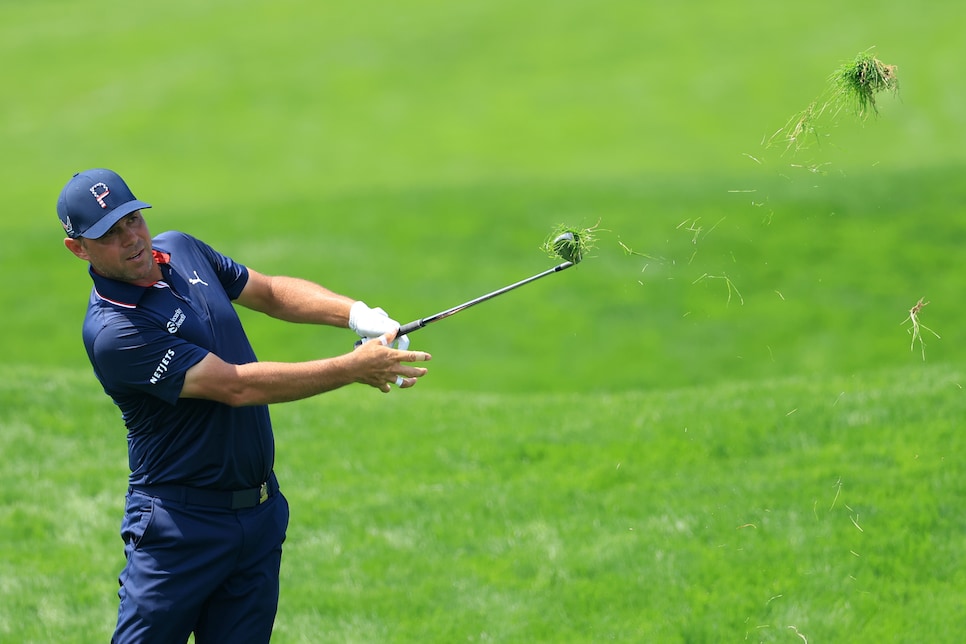OAKMONT, Pa. — Those watching from home sensed a disconnect between what they wanted and what they were seeing. They flooded social with anger and indignation, for they had come for carnage and chaos. Instead, they witnessed J.J. Spaun firing the lowest opening nine in the tournament’s 125-year history, Si Woo Kim prancing around like this was the Presidents Cup, qualifier Maxwell Moldovan holing out for eagle on the first while Shane Lowry made the first 2 in No. 3’s history. The monster lurking in the hills above the Allegheny River had been tamed and turned into TPC Pittsburgh.
Yet there was no need to reconcile expectation with reality—because no reconciliation is necessary. On Thursday at the U.S. Open, to paraphrase the immortal Denny Green, Oakmont is exactly what we thought it was.
Oakmont members and purists who demand their U.S. Opens run with masochistic precision often invoke a quote attributed to club co-founder William C. Fownes: “Let the clumsy, the spineless, the alibi artist stand aside. A shot poorly played should be a shot irrevocably lost.” While this sounds like the manifesto of someone who might benefit from therapy, it also serves as the True North for what an Oakmont Open should deliver. This is the tournament where thirsty influencers make balls vanish into impenetrable rough, where players helplessly observe putts oscillate and tumble off glass-slick greens, where grown men stare skyward in disbelief, searching for a prayer they know won’t be answered. In this sense, the benign early hours of Round 1 felt like a betrayal of this sacred brutality.
But golf—championship golf, at least—isn’t decided over a handful of holes, or even 18, or 54. The magic number is 72, a distance that has proven perfectly calibrated to separate contenders from pretenders. Though we’re barely a quarter of the way through this tournament, Thursday morning is already looking like an anomaly—a brief ceasefire in what promises to be a four-day war of attrition.
Just ask Shane Lowry, who held the 54-hole lead here in 2016. Lowry is genuinely a good man and charitable soul, someone who does considerable work behind the scenes without seeking recognition. But he’s not always the affable Irishman he’s perceived to be—he has a tendency to run hot when things go sideways. Anyone doubting this need only have followed him around Thursday, watching him express his displeasure with volunteers and journalists stationed along the ropes as he discovered parts of Oakmont he had no business visiting. At one point he angrily tossed aside a boom microphone after chunking a chip shot. Only that miraculous hole-out for eagle at the third prevented him from shooting in the 80s, limping home with a nine-over 79.
Or consider Lowry’s playing partner, Rory McIlroy. The Northern Irishman was the MVP of early 2025, capturing three victories and finally lifting the forever weight from his shoulders by completing the career Grand Slam. McIlroy has openly acknowledged his struggles with motivation in the afterglow of that green jacket—a perfectly human response that nonetheless bodes poorly for a course demanding relentless focus. He made the turn at two under, trailing only Spaun on the leaderboard, before surrendering four bogeys and a double bogey on the back nine to stumble to a four-over 74.

David Cannon
The marquee names had plenty of company in their misery. Bryson DeChambeau managed three over. Gary Woodland plummeted from three under to three over in a six-hole stretch. Tommy Fleetwood, Matt Fitzpatrick and Wyndham Clark all joined McIlroy at 74, with Patrick Cantlay lurking behind at 76. Justin Rose, who damn near captured the Masters two months ago, had to scramble to avoid shooting 80.
The broadcast may not have captured every meltdown unfolding across Oakmont, but the numbers tell the story. As the second wave of players battled the course Thursday morning, scoring averages climbed to five over par—a figure that puts this opening round in historical perspective. Consider the scoring averages from Oakmont’s last three U.S. Opens: 1994 averaged +5.24, 2007 came in at +5.32, and 2016 was the most forgiving at +4.23. And on this front, the USGA deserves recognition for learning from its mistakes. For years, the organization courted controversy that other majors avoided, prioritizing the sanctity of par over sensible course setup. Many golf fans embraced this approach, relishing the sight of the world’s best players made to look like the rest of us. But the line between demanding test and cruel punishment is razor-thin, and the USGA repeatedly stumbled across it. The resulting spectacles provided memorable television—Phil Mickelson’s rebellious putt at a moving ball during Shinnecock’s 2018 Saturday setup remains unforgettable—but championships that end with asterisks ultimately damage both the tournament’s reputation and the sport itself.
Now, could the greens have been firmer, faster, less receptive? Possibly, particularly with weekend weather forecasts suggesting conditions might soften the course naturally. Today might have been the perfect opportunity to unleash Oakmont’s full fury. However, pace of play remains a perpetual U.S. Open concern, and overly severe conditions could have slowed down an already slog. More importantly, while the USGA has moved past the player uprising of 2018, the current leadership remains acutely aware of the past and to keep it there. When the setup must lean one direction, they’re choosing the side of caution.
But caution and just five players in the morning wave breaking par does not seem copacetic. As with everything you see on social media, don’t believe what you see: The fire-and-brimstone Open remains, and the field has the burn marks to prove it.
MORE GOLF DIGEST U.S. OPEN COVERAGE
U.S. Open 101: Answering all your frequently asked questionsHow to watch the 2025 U.S. OpenPower Rankings: Every player in the U.S. Open field, rankedThe 13 best bets to win at OakmontTee times for the first and second roundMythbusters: How much distance do you lose from thick rough?The secret everybody misses about U.S. Open carnageThe local rule that could cause some chaos at OakmontThe top 15 U.S. Opens, rankedThe 18-hole hazard: The U.S. Open rough is impossible and simple30 fun facts on the 15 amateurs playing at OakmontThe ball moved, rules chaos followed and game changed forever
This article was originally published on golfdigest.com

